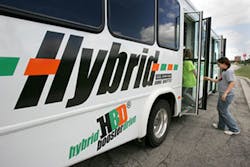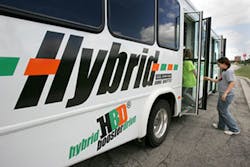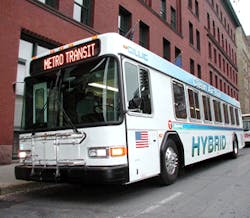From the perspective of public transit bus operations, though, the future prospects for hybrid system sales seems to be a resounding “thumbs up” – and if production volumes for such technology witnesses a significant increase, costs might starting declining too, which could further spur hybrid sales and their fuel saving benefits.
Chandramowli Kailasam, a senior research analyst with Frost & Sullivan’s automotive and transportation practice, recently noted that the ongoing tend of “rapid urbanization” in many parts of the world is placing a huge strain on city infrastructure and public transit systems – and as a result creating what he calls “environmental concerns” for governments.
“Governments have to make huge investments in upgrading infrastructure, but will be challenged in this endeavor by their dependence on fuel imports, volatile fuel prices, and increasing reliance on conventional fuels,” Kailasam argued. “In order to attain sustainable growth and economical passenger mobility, the transportation industry – especially the transit bus sector – will have to adapt to newer powertrain systems and other advanced technologies, such as connectivity and hub-and-spoke multi-modal urban mobility.”
That’s where hybrid propulsion comes into play, he thinks. Indeed, Frost & Sullivan’s research predicts that heavy-duty transit bus market trends indicates that sales of hybrid and electric (H&E) buses will grow at a compound annual growth rate of 20.6% by 2020 – a scant six or so years off – and estimates that hybrid buses will comprise 9.7% of the bus market by 2020, while electric buses build up to a 5.7% slice. Together, Kailasam believes H&E transit bus unit shipments will reach close to 42,000 units in six years’ time.
“Hybridization and electrification of powertrain is poised to become a global phenomenon in transit buses by 2020,” he added. “This trend will be driven by cash incentives, tax subsidiaries, stringent emission laws, regulations mandating green powertrains in transit buses for urban use, and overall financial aid for green technology.”The big benefit driving H&E sales in the transit bus sector is the reduction in fuel consumption, as such “green” powertrain systems are expected to not only improve fuel efficiency but act as a “hedge” against hikes in fuel price and ridership cost.
“The recent increase in the growth of bus rapid transit systems in many American and Canadian cities shows that hub-and-spoke mass transit systems are being developed to solve urban mobility and in this scheme of things, H&E buses will play an integral role,” added Kailasam.
Yet demand for hybrids seems to be increasing from other vehicle sectors, too, most notably passenger cars.
In fact, a recent report from Swapalease.com found that vehicles in the Green/Hybrid segment led all lease categories in September, rising 66.7% compared to year-ago levels.
“Since the recession we’ve seen a steady rise in the number of Green/Hybrid vehicles in the Swapalease.com marketplace,” said Scot Hall, the firm’s executive vice president. “We anticipate this trend to continue in the near term, particularly with the strong emphasis on lease deals for these eco-friendly vehicles.”He added that car manufacturers have rolled out more options in the Green/Hybrid category over the last few years, and consumers have responded with more interest. “Manufacturers and dealers have also introduced more attractive lease programs on these vehicles, which helps to explain the rise in transfer activity for these vehicles,” Hall noted.
[Interestingly, Swaplease.com found that trucks are third lowest in terms of lease transfer activity, with just a 4.8% change from a year ago, despite higher overall interest in consumer shopping for trucks, while vans lead all segments in the downward sloping category with a negative 37.5% change from year-ago levels.]
One reason for the surge in hybrid car demand relates to an improvement in their fuel saving matrix, according to a recent whitepaper put together by vehicle asset management firm Donlen.
Thus it seems at least some of the stars may be aligning to favor hybrid propulsion systems in some vehicle sectors. Let’s if that favoring translates into larger production volumes as we move down the road.



